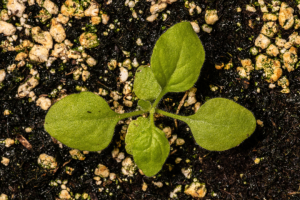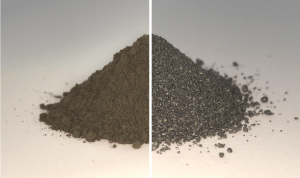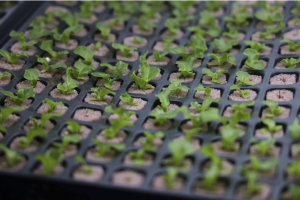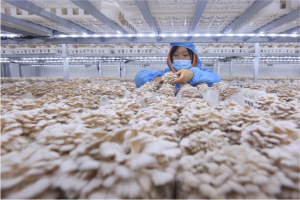NASA has estimated that the crew of a six-person space mission to Mars would require about 10,000 kilograms of food to cover the three-year return trip. This is without taking into account that some essential micronutrients present in these foods, including many vitamins, will break down over time in storage. So if humans ever want to settle on the Moon and Mars, and travel and even live in space—which they do, and the various space agencies have already set deadlines for doing so—the first step is to ensure that astronauts and colonists are properly fed. This means being able to grow vegetables in space to provide a self-sufficient supply of fresh food. For this reason, much research is focused on the challenge of growing crops for (living in) space.
Using earth on the Moon
Given that the necessary light, humidity and ventilation conditions can be easily replicated in an artificial greenhouse, the main constraint on growing vegetables on the Moon is the availability of fertile earth, as transporting soil from Earth to the lunar surface is not a viable option. Lunar soil, known as regolith, has specific characteristics that make it different from terrestrial soil, but not that much. Regolith contains no organic matter or moisture, but is made up of the same minerals as Earth’s soil, albeit in different proportions. In fact, it is possible to grow some plants in samples of lunar soil collected by the Apollo missions, but the problem is that they don’t grow or develop sufficiently.

One of the lines of research being pursued is to enrich lunar regolith with bacteria and micro-organisms that modify its properties sufficiently to allow crops to thrive. For example, Chinese researchers have successfully grown Nicotiana benthamiana plants after seeding lunar soil with three different types of bacteria. At the same time, researchers are also looking for crop varieties that are more adaptable to the original lunar soil conditions in order to find an intermediate point between modifying the regolith and the ability of the plants to develop satisfactorily.
Hydroponic crops, lunar fertiliser
Another avenue currently being explored by the European Space Agency (ESA) to exploit the potential of lunar regolith is to use it not as a substrate, but as a fertiliser for hydroponic crops. In this case, the necessary nutrients would be obtained from lunar soil by means of various mechanical and physicochemical treatments. Once extracted, they would be dissolved in water to irrigate the hydroponic garden.

From photosynthesis to chemosynthesis
But the most ambitious line of research is undoubtedly the quest to create plants that can develop and be cultivated in the absence of light, or the dim lighting of spacecraft and space stations. Plants depend on solar energy to convert CO2 and water into sugars during photosynthesis. These sugars serve a dual function: some are used as raw materials to produce new molecules and structures, and others are consumed as fuel in the Krebs cycle, a metabolic pathway by which plants obtain the chemical energy they need to grow. One possibility, therefore, would be to use hydroponic cultures in an aqueous medium that also contains the necessary sugars, which would be assimilated through the roots. The main obstacle is that the production of complex plant-like sugars in electrical reactors (electrolysers) from CO2 (expelled by the crew) and water is not currently feasible because of the high cost, nor is transporting them from Earth. Research is therefore being carried out into the design of equipment and syntheses to optimise this production. At the same time, work is underway to minimise plants’ need for sugars; researchers are developing miniature plants and/or genetically modified varieties that have minimal biomass (inedible leaves, stems and flowers), so that more of the plant’s resources can be devoted to the production of edible leaves or fruit.

Endless germination
There is a short period in the life of a plant—the germination of the seed—when it is able to develop in the absence of light (underground). At this stage, certain genes are activated that code for the synthesis of enzymes that set in motion an alternative metabolic pathway (a shortcut within the Krebs cycle): the so-called glyoxylate cycle. The interesting thing about this alternative pathway is that it generates less energy per cycle, but it also works with simpler fuels such as acetate, a hydrocarbon with only two carbon atoms. This compound can also be used as a feedstock for plant synthesis of the necessary molecules and structures, and it is possible to produce acetate from CO2 and water in electrolysers. Researchers are therefore currently investigating the permanent activation of these genes through gene editing. This would make it possible to grow genetically modified plants in an acetate-enriched hydroponic medium.

Heterotrophic crops
This is not the only possibility offered by genetic research. Plants need photosynthesis because they are autotrophic organisms, i.e. they produce their own food and cannot obtain it from the environment. But there are crops that can and do develop in the absence of light: fungi (including mushrooms and truffles), for example, are heterotrophic organisms that we cultivate and that obtain the carbon they need from decomposing organic matter. Another line of research is therefore aimed at identifying and isolating the genes that give them their heterotrophic capacity, in order to create genetically modified plant varieties that will one day be able to obtain the necessary carbon from the decomposing organic matter that life on the space station will generate.
Comments on this publication